East Cheshire AGS Show, 2011
Over the 30 or so years I've attended this late spring Show it been held in an assortment of venues in a generally leafy and affluent sector of Cheshire, Macclesfield marking the most southerly outposts, the lower fringes of Manchester (Bramhall) the northernmost. A shift to Wilmslow High School, just a few miles north-east of last year's Mobberley substitution, represented a quantum leap when it came to the provision of natural light, and space to stage exhibits. The well-tended, generously-sized front gardens of the houses along the approach road provided evidence of either their owners' horticultural activities or, equally likely in this enclave of personal trainers, smart chocolatiers and lifestyle coaches, part-time garden staff.
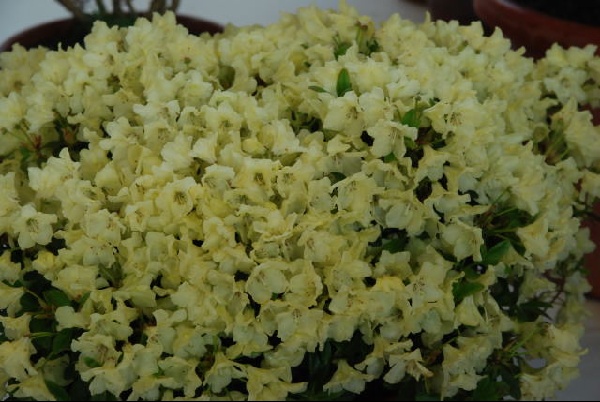 Prominent in these gardens, apart from the wallflower and tulip interplantings, and the Wisteria-clad house walls, were Exbury-type azaleas in bright orange and several shades of brilliant yellow. These were in their prime, whereas their dwarfer cousins within the showhall, although well-represented numerically, showed signs of weariness after yet another warm, windy, rain-free week, so that in many the apex of any given raceme was in its prime, but the basal elements were drooping and dropping by the hour. A previous Farrer Medal recipient, Rhododendron 'Sarled' (Southport 2004, Ron & Hilary Price) was in peak bloom, but reduced to its outermost two branches, as if artistically pruned in bonsai fashion. Awarded first prize in its keenly-contested class (and thereafter the travelling Ralph Haywood Trophy for best dwarf shrub exhibited), Sam & Mavis Lloyd's R. 'Wagtail' was audaciously floriferous This delicate yellow, 1971 Glendoick 'bird' hybrid between R. lowndesii and R. keiskei var. ozawae 'Yaku Fairy', up to 20 cm tall at maturity, is less frequently seen than R. 'Wren' (where R. ludlowii is substituted in the seed parentage), which peaks a week or two earlier on, and is rather larger of funnel.
Prominent in these gardens, apart from the wallflower and tulip interplantings, and the Wisteria-clad house walls, were Exbury-type azaleas in bright orange and several shades of brilliant yellow. These were in their prime, whereas their dwarfer cousins within the showhall, although well-represented numerically, showed signs of weariness after yet another warm, windy, rain-free week, so that in many the apex of any given raceme was in its prime, but the basal elements were drooping and dropping by the hour. A previous Farrer Medal recipient, Rhododendron 'Sarled' (Southport 2004, Ron & Hilary Price) was in peak bloom, but reduced to its outermost two branches, as if artistically pruned in bonsai fashion. Awarded first prize in its keenly-contested class (and thereafter the travelling Ralph Haywood Trophy for best dwarf shrub exhibited), Sam & Mavis Lloyd's R. 'Wagtail' was audaciously floriferous This delicate yellow, 1971 Glendoick 'bird' hybrid between R. lowndesii and R. keiskei var. ozawae 'Yaku Fairy', up to 20 cm tall at maturity, is less frequently seen than R. 'Wren' (where R. ludlowii is substituted in the seed parentage), which peaks a week or two earlier on, and is rather larger of funnel.
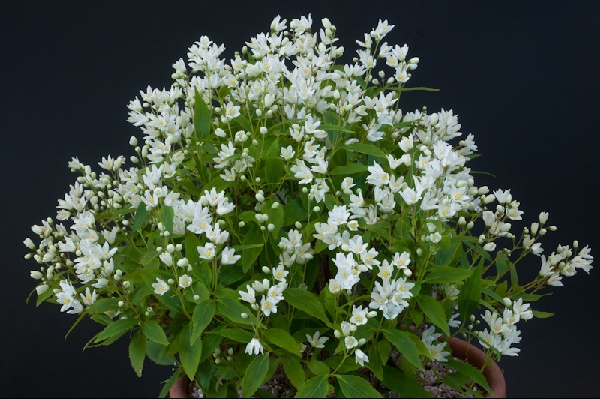 On the other side of the bench, John Dower's Deutzia gracilis 'Nikko' (John Dower), part of a winning three-pan entry, was a three or four year old specimen, pleasantly abundant with sprays of smallish white flowers. One of the dwarfest and earliest in bloom of its distinguished genus, it is long-lived and will eventually sucker and spread from a branched rootstock to form an open-ground specimen over a metre across.
On the other side of the bench, John Dower's Deutzia gracilis 'Nikko' (John Dower), part of a winning three-pan entry, was a three or four year old specimen, pleasantly abundant with sprays of smallish white flowers. One of the dwarfest and earliest in bloom of its distinguished genus, it is long-lived and will eventually sucker and spread from a branched rootstock to form an open-ground specimen over a metre across.
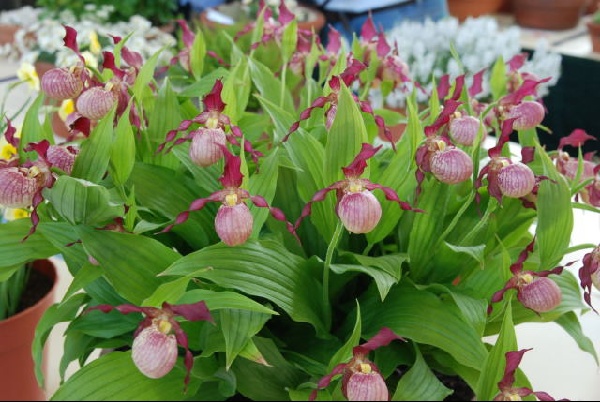 In some previous years at this Show, six or more plants have been considered for the Farrer Medal. This time round, with the season several weeks advanced, there was just one obvious contender, Cypripedium Gisela grex (Robin Pickering), in a two-tone raspberry phase rather than its paler through to lemon versions, and as such close to the plant that won through four years previously at the same Show (when the present exhibitor's wife was the recipient). A 20 year old cross between the American C. parviflorum and the Eurasian C. macranthos, it was most closely rivalled by Brian Burrow's yellow-pouched, blackish sepalled C. parviflorum x calceolus, a Peter Corkhill cross of upright bearing that had been in the same smallish pot for five years or more, and bore some 40 shoots, half of them with single flowers to their credit.
In some previous years at this Show, six or more plants have been considered for the Farrer Medal. This time round, with the season several weeks advanced, there was just one obvious contender, Cypripedium Gisela grex (Robin Pickering), in a two-tone raspberry phase rather than its paler through to lemon versions, and as such close to the plant that won through four years previously at the same Show (when the present exhibitor's wife was the recipient). A 20 year old cross between the American C. parviflorum and the Eurasian C. macranthos, it was most closely rivalled by Brian Burrow's yellow-pouched, blackish sepalled C. parviflorum x calceolus, a Peter Corkhill cross of upright bearing that had been in the same smallish pot for five years or more, and bore some 40 shoots, half of them with single flowers to their credit.
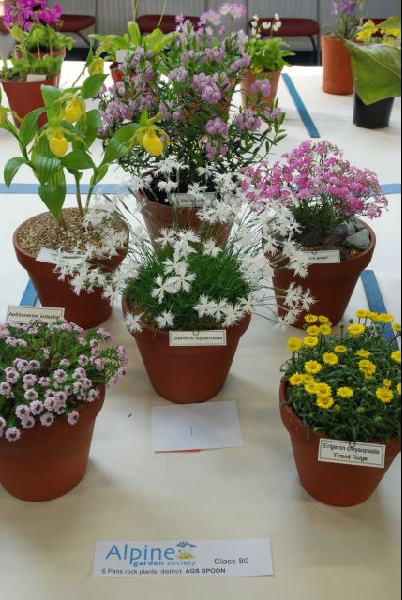
In truth there were more orchids outside the showhall (courtesy of Laneside Hardy Orchid Nursery) than within, though another newish Cypripedium hybrid, a five-flowered, pale greenish of sepal and yellow-pouched 'Pueblo', distributed of late by a Dutch nursery, helped Anne Vale win the six-pan class in the Intermediate Section (the entry also included an orderly, well-flowered Phlox grayi). Elsewhere her Aethionema kotschyi (which dislikes root disturbance, and as such is seldom serially successful when grown in a pot) was victorious, adding to a points total that secured the Cheshire Salver.
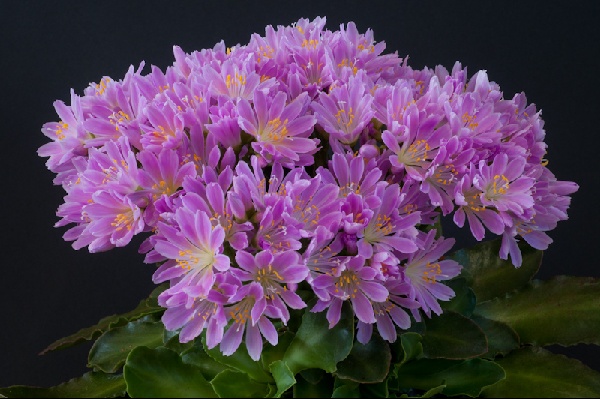 The Intermediate Section of this Show held up particularly well, and several of the entries outshone examples of the same plant exhibited in the Open Section. Jackie Street's Hosta 'Cracker Crumbs' was a wavy-leaved, yellowish-green, dark margined miniature, reputedly reaching 30 cm across but dwarf (under 10 cm in leaf; 18 cm in flower) bred by Bob Solberg (Green Hill Hostas, North Carolina) in 2002. It's a tissue culture sport of his earlier hybrid 'Shiny Penny' (= 'Lemon Lime' x 'Shiny Tot' (1997)). Here too was the yet more exuberant, broader-bladed and similarly transistorized H. 'Pandora's Box' (Norman Davis), a 1996 sport of 'Baby Bunting' from Shady Oaks Nursery whose acuminate leaves were strikingly white-splashed, with slightly irregular greyish-green and lime-green striped borders. The same exhibitor also had a showy Lewisia cotyledon hybrid - possibly with L. brachycalyx, judging by the broad foliage and the flower shape - whose rich pink flowers were uniformly fresh. Exhibiting a plant in such condition when in full (rather than early) bloom presupposes last-minute grooming, for the older flowers shrivel very rapidly following a warm car journey.
The Intermediate Section of this Show held up particularly well, and several of the entries outshone examples of the same plant exhibited in the Open Section. Jackie Street's Hosta 'Cracker Crumbs' was a wavy-leaved, yellowish-green, dark margined miniature, reputedly reaching 30 cm across but dwarf (under 10 cm in leaf; 18 cm in flower) bred by Bob Solberg (Green Hill Hostas, North Carolina) in 2002. It's a tissue culture sport of his earlier hybrid 'Shiny Penny' (= 'Lemon Lime' x 'Shiny Tot' (1997)). Here too was the yet more exuberant, broader-bladed and similarly transistorized H. 'Pandora's Box' (Norman Davis), a 1996 sport of 'Baby Bunting' from Shady Oaks Nursery whose acuminate leaves were strikingly white-splashed, with slightly irregular greyish-green and lime-green striped borders. The same exhibitor also had a showy Lewisia cotyledon hybrid - possibly with L. brachycalyx, judging by the broad foliage and the flower shape - whose rich pink flowers were uniformly fresh. Exhibiting a plant in such condition when in full (rather than early) bloom presupposes last-minute grooming, for the older flowers shrivel very rapidly following a warm car journey.
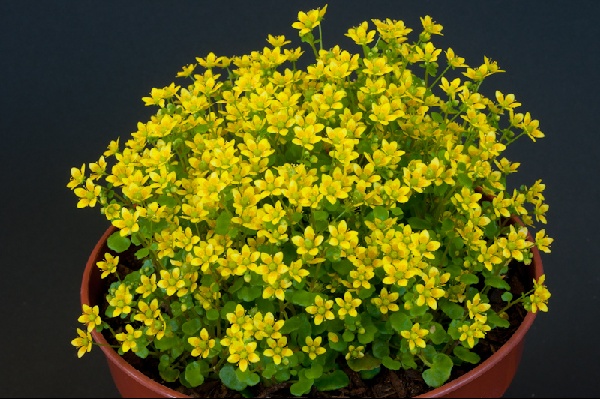 Saxifraga cymbalaria var. huetiana (Pamela Anderson) made a pleasant change from the otherwise ubiquitous S. pubescens 'Snowcap'. Much more easily managed too, it thrives in the damp and shade that would hardly suit the latter. Representing the eastern, mainly Turkish and Caucasian end of the species' disjunct distribution, this short-lived, buttercup yellow opportunist flowers all summer long and self-sows freely, though because it is shallow-rooted, it can easily be kept in bounds by some ruthless weeding, followed by a heavy mulch.
Saxifraga cymbalaria var. huetiana (Pamela Anderson) made a pleasant change from the otherwise ubiquitous S. pubescens 'Snowcap'. Much more easily managed too, it thrives in the damp and shade that would hardly suit the latter. Representing the eastern, mainly Turkish and Caucasian end of the species' disjunct distribution, this short-lived, buttercup yellow opportunist flowers all summer long and self-sows freely, though because it is shallow-rooted, it can easily be kept in bounds by some ruthless weeding, followed by a heavy mulch.
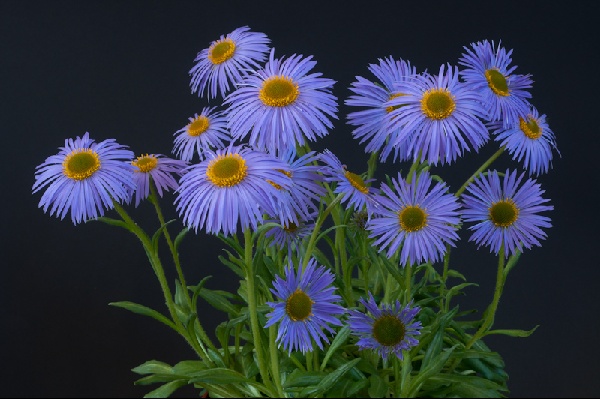 Moving to the Open Section, another infrequent visitor to the show bench, Aster souliei (Ian Instone), made one wonder why this plant isn't grown more often. First brought back almost a century ago by Farrer and named A. limitanus (which was later reduced to varietal status, it can range in height from 5-45 cm but always the flowers are of good size (7 cm in the plant shown) and with purplish-blue ray florets around a rich yellow centre. It occurs in Gansu, Sichuan, Yunnan, Xizang and northern Myanmar at up to 4000 m, often as an element of the alpine meadow flora, or at the edge of pine woodland, flowering from May until July. At present it is listed by only a handful of nurseries.
Moving to the Open Section, another infrequent visitor to the show bench, Aster souliei (Ian Instone), made one wonder why this plant isn't grown more often. First brought back almost a century ago by Farrer and named A. limitanus (which was later reduced to varietal status, it can range in height from 5-45 cm but always the flowers are of good size (7 cm in the plant shown) and with purplish-blue ray florets around a rich yellow centre. It occurs in Gansu, Sichuan, Yunnan, Xizang and northern Myanmar at up to 4000 m, often as an element of the alpine meadow flora, or at the edge of pine woodland, flowering from May until July. At present it is listed by only a handful of nurseries.
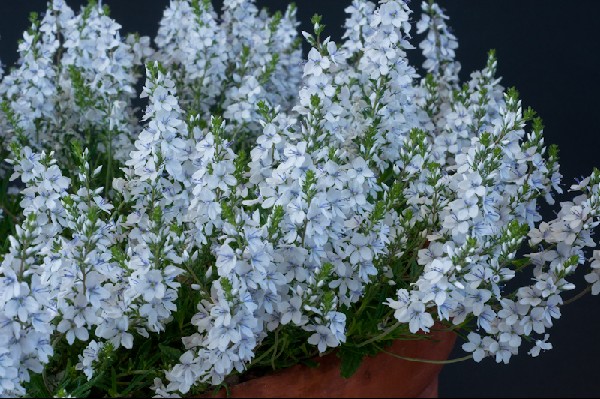 Another first-rate garden plant, Veronica prostrata, is seldom exhibited, perhaps because, in common with many of the genus, it sheds its flowers by the hundred when at the height of its display. Normally true blue, but occasionally pink, white, or even yellow-leaved, in the clone 'Blue Sheen' (shown by Chris Lilley) the flowers are a very pale blue, with the anthers and stamens navy in striking contrast. A very close relative, Paederota, is chiefly represented in gardens by that cliff-dweller from the Dolomites and the southern Alps P. bonarata. The other species in the genus, P. lutea, is little-grown, although as Cliff Booker's panful demonstrated, it has a certain charm, quite apart from the novelty of its pale yellow flowers.
Another first-rate garden plant, Veronica prostrata, is seldom exhibited, perhaps because, in common with many of the genus, it sheds its flowers by the hundred when at the height of its display. Normally true blue, but occasionally pink, white, or even yellow-leaved, in the clone 'Blue Sheen' (shown by Chris Lilley) the flowers are a very pale blue, with the anthers and stamens navy in striking contrast. A very close relative, Paederota, is chiefly represented in gardens by that cliff-dweller from the Dolomites and the southern Alps P. bonarata. The other species in the genus, P. lutea, is little-grown, although as Cliff Booker's panful demonstrated, it has a certain charm, quite apart from the novelty of its pale yellow flowers.
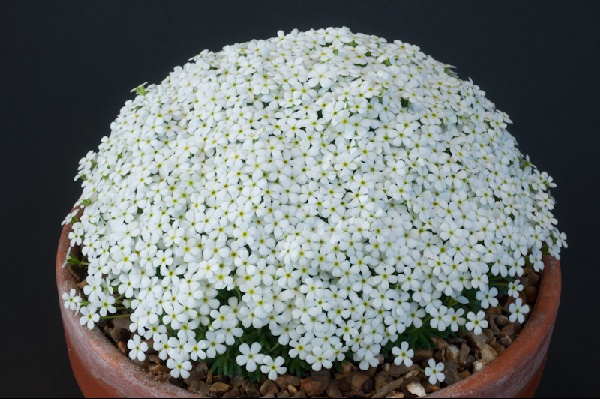 The unofficial award for most flowers per square inch of foliage could have gone to any of several cushion androsaces, but one labelled A. hirtella (Sam Sutherland) was notably floriferous, and was awarded the G.F. Smith Trophy. Several of those present had specialist knowledge of the relatively small differences separating some of the species, and all were in accord that this wasn't one of the many hybrids with A. cylindrica that occur so freely in cultivation. If it was indeed the 'old' A. hirtella (as distinct from a more recent introduction a decade ago, seen at northern shows most years) then the pedicels were twice the length usually given: '[they] rarely exceed 3 mm' wrote the man in whose memory the award is given.
The unofficial award for most flowers per square inch of foliage could have gone to any of several cushion androsaces, but one labelled A. hirtella (Sam Sutherland) was notably floriferous, and was awarded the G.F. Smith Trophy. Several of those present had specialist knowledge of the relatively small differences separating some of the species, and all were in accord that this wasn't one of the many hybrids with A. cylindrica that occur so freely in cultivation. If it was indeed the 'old' A. hirtella (as distinct from a more recent introduction a decade ago, seen at northern shows most years) then the pedicels were twice the length usually given: '[they] rarely exceed 3 mm' wrote the man in whose memory the award is given.
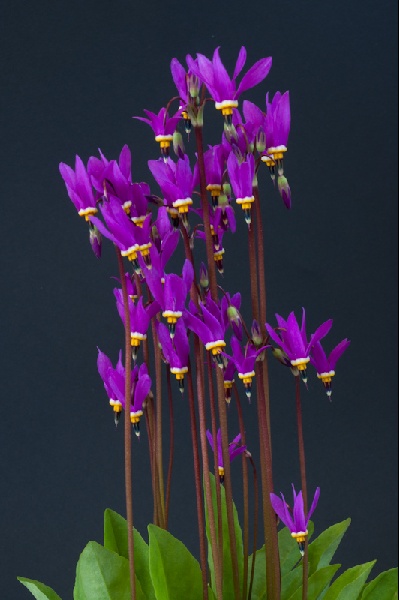
More debatable still were the labels attached to most examples of another distinguished bastion of Primulaceae, viz. Dodecatheon. One infers that commercial and seed list offerings are mightily muddled. Tony Rymer had a fine clump of D. pulchellum, one of the most rewarding species, which with me sets an abundance of seed annually, and can also be propagated easily by division as the new shoots appear in early spring. In whatever guise it first comes to you, a very rewarding plant!
